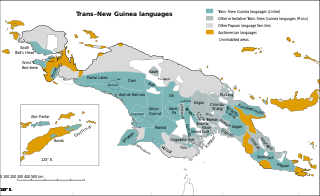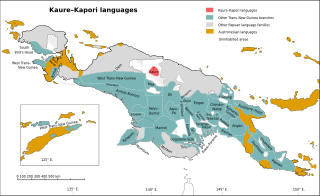Related Research Articles

Trans–New Guinea (TNG) is an extensive family of Papuan languages spoken on the island of New Guinea and neighboring islands, a region corresponding to the country Papua New Guinea as well as parts of Indonesia.

The Papuan languages are the non-Austronesian languages spoken on the western Pacific island of New Guinea, as well as neighbouring islands in Indonesia, Solomon Islands, and East Timor. It is a strictly geographical grouping, and does not imply a genetic relationship.
The Sko or Skou languages are a small language family spoken by about 7000 people, mainly along the Vanimo coast of Sandaun Province in Papua New Guinea, with a few being inland from this area and at least one just across the border in the Indonesian province of Papua.

The East Geelvink Bay or East Cenderawasih languages are a language family of a dozen Papuan languages along the eastern coast of Geelvink Bay in Indonesian Papua, which is also known as Sarera Bay or Cenderawasih.

The Torricelli languages are a family of about fifty languages of the northern Papua New Guinea coast, spoken by about 80,000 people. They are named after the Torricelli Mountains. The most populous and best known Torricelli language is Arapesh, with about 30,000 speakers.

The West Papuan languages are a proposed language family of about two dozen non-Austronesian languages of the Bird's Head Peninsula of far western New Guinea, the island of Halmahera and its vicinity, spoken by about 220,000 people in all. It is not established if they constitute a proper linguistic family or an areal network of genetically unrelated families.
The Nimboran languages are a small family of Papuan languages, spoken in the Grime River and Nawa River watershed in Jayapura Regency, that had been part of Stephen Wurm's Trans–New Guinea proposal. However, when proto-Nimboran pronouns are reconstructed (*genam "I" and kom or komot "thou"), they have little resemblance to the proto-TNG pronouns *na and *ga. Usher places them in a North Papuan stock that resembles Cowan's proposal.
Isirawa is a Papuan language spoken by about two thousand people on the north coast of Papua province, Indonesia. It is a local trade language, and use is vigorous. Stephen Wurm (1975) linked it to the Kwerba languages within the Trans–New Guinea family, and it does share about 20% of its vocabulary with neighboring Kwerba languages. However, based on its pronouns, Malcolm Ross (2005) felt he could not substantiate such a link, and left it as a language isolate. The pronouns are not, however, dissimilar from those of Orya–Tor, which Ross links to Kwerba, and Donahue (2002) accept it as a Greater Kwerba language.
The Burmeso language – also known as Taurap – is spoken by some 300 people in Burmeso village along the mid Mamberamo River in Mamberamo Tengah subdistrict, Mamberamo Raya Regency, Papua province, Indonesia. It is surrounded by the Kwerba languages to the north, the Lakes Plain languages to the south, and the East Cenderawasih Bay languages to the west.

The South Halmahera–West New Guinea (SHWNG) languages are a branch of the Malayo-Polynesian languages, found in the islands and along the shores of the Halmahera Sea in the Indonesian province of North Maluku and of Cenderawasih Bay in the provinces of Papua and West Papua. There are 38 languages.
Warembori is a moribund language spoken by about 600 people in Warembori village, Mamberamo Hilir District, Mamberamo Raya Regency, located around river mouths on the north coast of Papua, Indonesia.

The Kaure–Kosare or Nawa River languages are a small family spoken along the Nawa River in West Papua, near the northern border with Papua New Guinea. The languages are Kaure and Kosare.
West Bird's Head languages are a small family of poorly documented Papuan languages spoken on the Bird's Head Peninsula of New Guinea.

The North Halmahera (NH) languages are a family of languages spoken in the northern and eastern parts of the island of Halmahera and some neighboring islands in Indonesia. The southwestern part of the island is occupied by the unrelated South Halmahera languages, which are a subgroup of Austronesian. They may be most closely related to the languages of the Bird's Head region of West Papua, but this is not well-established.

Mor is a nearly extinct Trans–New Guinea language of Indonesia. It is spoken along the Budidi River and the Bomberai River on the Bomberai Peninsula.
Massep is a poorly documented Papuan language spoken by fewer than 50 people in the single village of Masep in West Pantai District, Sarmi Regency, Papua. Despite the small number of speakers, however, language use is vigorous. It is surrounded by the Kwerba languages Airoran and Samarokena.
Molof is a poorly documented Papuan language spoken by about 200 people in Molof village, Senggi District, Keerom Regency.
Yoke is a poorly documented language spoken by about 200 people in the north of Papua, Indonesia. The name is also spelled Yoki, Yauke, and it is also known as Bitovondo. It was spoken in a single village in the interior until the government relocated a third of the population to a new village, Mantarbori, on the coast. In the late 19th century, a word list of "Pauwi" was collected by Robidé van der Aa at Lake Rombebai, where the Yoke say they migrated from; this is transparently Yoke, apart from some words which do not appear in the modern language but are found in related Warembori.
Yetfa and Biksi are dialects of a language spoken in Jetfa District, Pegunungan Bintang Regency, Highland Papua, Indonesia, and across the border in Papua New Guinea. It is a trade language spoken in Western New Guinea up to the PNG border.
The Kwerbic, or Greater Kwerba, languages are a family of just under a dozen Papuan languages spoken in Indonesia.
References
- Ross, Malcolm (2005). "Pronouns as a preliminary diagnostic for grouping Papuan languages". In Andrew Pawley; Robert Attenborough; Robin Hide; Jack Golson (eds.). Papuan pasts: cultural, linguistic and biological histories of Papuan-speaking peoples. Canberra: Pacific Linguistics. pp. 15–66. ISBN 0858835622. OCLC 67292782.